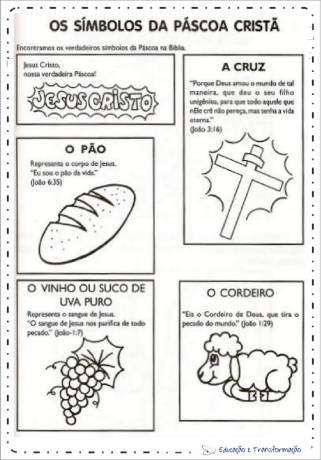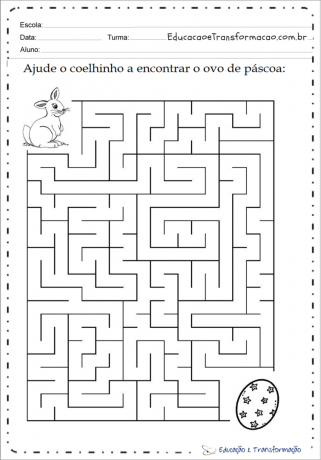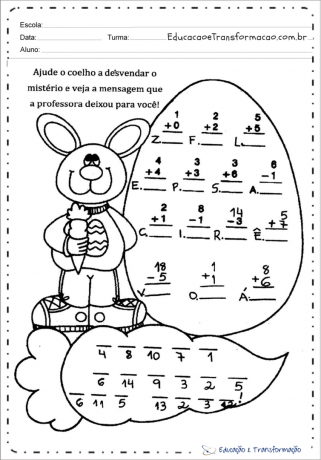We selected in this post several suggestions for Easter Activities for Elementary School, ready to print and apply to early graders, in the classroom, or as a homework assignment. are excellent educational suggestions, with ideas of dynamics and games.
Easter is a Christian celebration celebrated annually on Sunday, known as Easter Sunday.
See too:
Index
Easter symbols and their meanings:

Don't miss: Story the non-Easter egg

The symbols of the Christian Easter

Find words from the text in word search:

Write the name of the objects on the side in the blank comics:

Easter Activities for Elementary School - Cruzadinha
Children's Play for Easter Week
This game will require a lot of space. Then make a chalk mark on the floor and divide the class into teams. After the “already”, everyone will have to jump, like a bunny, to the finish line. The team representative who arrives first will win.
Tell your children that during the night the bunny hid several eggs around the house. The child just needs to look. To make the game even more fun, glue the rabbit's footprints that can be made of paper to the floor. You can also use talcum powder and your fingers to simulate the pet's footprints.
Get the children together to paint the chicken eggs. Painted eggs can be given as gifts to grandparents and uncles. In order not to have too much dirt, it is better to work with eggs that have already been cooked.
The child needs to pick up a hard-boiled egg, put a spoon in his mouth or hand, and run around balancing the egg. Whoever arrives first without dropping the egg is the big winner.
It's like a secret friend, but Easter. In it, each participant must draw a paper with the name of another participant – and must not tell anyone who they are. On the day of the game, using tips, the others try to guess who it is. When this occurs, there is an exchange of Easter eggs. Who receives the egg is the next one who gives the tips, and so on.
Distribute hula hoops on the floor. Each child must be inside a hula hoop. Whenever you yell, “bunny come out of the hole”, the kids should switch hula hoops. Whoever is left out has to wait for the next round. In each round you must take a hula hoop to make it difficult to play.
Draw a giant rabbit on cardboard and hang it on the wall. Then draw the rabbit's tail separately and tape the end of it. A blindfolded participant must put their tail in the right place, all this with everyone guessing and joking.
Play this game as if it were a normal bingo. With the table in the shape of an egg and inside it the numbers. Each time you take a number, the child checks whether there is one or not. So when the kid binges all the numbers he's the big chocolate egg winner.
Here are some suggestions for Easter Activities for Elementary School to print and color:


assemble the story

Let's sing the song:

Help the rabbit find the easter egg

Let's circle the letters in the alphabet

Hunting words

Help the rabbit to unravel the mystery and see the message the teacher left for you

Paint the initial letter of the word easter

More activities in:
Always thinking of making it easy for you, we decided to make all the Easter Activities for Elementary School shown above in a single PDF file. To access the material and download it, check the following link:
Easter Activities for Elementary School - Fun and Dynamics
Age: 5 - 12 years
Material: Small chocolate eggs (minimum 1 per child), spoon (1 per team), cones (1 per team), baskets (1 per team) chalk.
Objective: Perform fundamental motor skills of locomotion and stabilization. Perform teamwork. Understand the competitive game.
Age: 7 - 14 years old
Material: Cards with drawings/words depicting Easter symbols (eggs, rabbit, basket, religious symbols, food)
Objective: Discuss the meaning of Easter. Express yourself with gestures.
In a round of conversation discuss the meaning of Easter and its symbols. Clarify any doubts.
Each child must remove a card without the others seeing it. One participant at a time will perform mimics that represent their card and the others will try to guess what it is.
It can be done in a group.
Age: 3 - 8 years old
Material: Chalk, cones (or other marking materials)
Objective: Perform fundamental motor skill of locomotion (jumping). Perform teamwork. Understand the competitive game.
To make it easier:
To make it more difficult:
Age: 3 - 8 years old
Material: Chalk (or other marking material)
Objective: Perform fundamental motor skill of locomotion (jumping distance) and stabilization (dynamic balance).
Age: from 3 years old.
Material: Cardboard with the design of an Easter bunny, from the back. Pom-pom made of wool or other material. Masking tape. Sale.
Objective: Perform fundamental motor skill of locomotion and stabilization. Improve the notion of space.
Rotate the blindfolded participant facing the cardboard. He should stick the rabbit's tail in the proper place.
This is perhaps the most traditional game for Easter. Basically the eggs are hidden and kids should find them, but there are several ways to make it more interesting for kids.
Age: 3 – 10 years
Material: chocolate eggs (minimum 1 per child). Basket to collect eggs.
Objective:
Specific material: flour or white gouache.
Hide the eggs and leave the rabbit's “footprints” nearby.
Make a round of conversation and tell in a “gossip tone” that a bumbling rabbit decided to hide the eggs, but left some clues… Let's look for it?!
Specific material: Cardboard with the design of a bunny using various accessories (glasses, scarf, bag… and basket with eggs). Each of the accessories used by the rabbit.
Specific objective: memorization
Hide the eggs and leave a rabbit accessory nearby.
Make a conversation circle and tell the story of the messy rabbit, show the “photo” of the rabbit (drawn cardboard). Ask the children to help find the lost objects.
Subscribe to our email list and receive interesting information and updates in your email inbox
Thanks for signing up.
